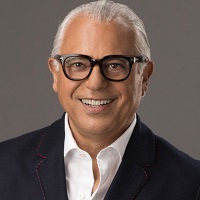
MyEDC gets you the answers you need
Join more than 30,000 Canadians who rely on MyEDC to grow their businesses with confidence.
June 26, 2024

Jeff Nankivell, president and CEO of the Asia Pacific Foundation of Canada (APFC), talks to host Joe Mimran about Southeast Asia, an exciting emerging market brimming with potential for Canadian exporters. Together, they investigate the market and discuss how Canadians can find trade and investment opportunities to grow their business and prosper.
Where to listen
Follow us on your favourite streaming platforms to never miss an episode of the Export Impact Podcast. Tune into our podcast for new episodes every second Wednesday at 6 a.m. ET.
Joe Mimran (00:00): Welcome back to the Export Impact Podcast, where we take you on an exhilarating journey through the world of international trade. I'm your host, Joe Mimran, and we're embarking on an adventure to Southeast Asia, a region brimming with opportunities for Canadian exporters. But first, let's set the stage for this incredible voyage.
The Indo-Pacific region is a powerhouse. It's home to a whopping 40 economies, more than four billion people in a mind-blowing $47 trillion in economic activity. It's the fastest-growing region in the world. Not only that, but six of Canada's Top 13 trading partners can be found right here with projections indicating that by 2040, the Indo-Pacific will account for more than half of the global economy. It's clear that Canadian relationships with this region are vital for long-term prosperity at economic success. And who better to guide us through this dynamic landscape than our guest today, Jeff Nankivell, the CEO of the Asia Pacific Foundation (APF) of Canada.
Prior to Jeff joining APF in 2021, he had a 33-year career in Canada's foreign service. He held various positions at the Canadian International Development Agency (CIDA), affluent Mandarin speaker. And from 2011 to 2016, Jeff served in Ottawa-Gatineau's director general responsible for Canada's official development assistance program across Asia.
I'd like to begin today's episode by acknowledging that we're recording from my office in Toronto, which is on the traditional unceded territory of many nations, including the Mississaugas of the Credit, the Anishnabeg, the Chippewa, the Haudenosaunee, and the Wendat peoples, and is now home to many diverse First Nations, Inuit and Metis people. We value taking this moment to deepen the appreciation of our Indigenous communities wherever we are, and to remind ourselves of our shared debt to Canada's first peoples.
It’s a real pleasure to have you here and thank you for joining us.
Jeff Nankivel (02:14): Thanks Joe to you and to EDC for having me. It's a pleasure.
Joe Mimran (02:18): First of all, can you tell us a little bit more about the Asia Pacific Foundation of Canada, what it is and what you do?
Jeff Nankivel (02:25): Sure. The Asia Pacific Foundation of Canada was established by an act of Parliament in 1984 to be a national public institution, a not-for-profit foundation independent of the government, with a mandate to promote Canadian engagement with the Asia Pacific region at a time when historically, Canadian focus for most of the country had been south to the United States (U.S.) and east to Europe. The foundation was created with this mandate to promote mutual awareness and understanding between people and firms and institutions and governments in Asia and Canada.
We'll be celebrating our 40th anniversary next year. In 2005, the foundation was getting annual funding for about the first 20 years of its existence. The government provided an endowment fund capital of $50 million with the idea that the foundation would independently manage its endowment and fund its core operations with the proceeds of investing the endowment. Today, we're an operation of a team of just under 50 staff, including some visiting scholars and researchers with the head office in Vancouver. And we have an office in Toronto and we’re gearing up to establish an office next year in the heart of Southeast Asia in Singapore.
Joe Mimran (03:51): Singapore. That's exciting. And where are you based?
Jeff Nankivel (03:55): I'm based in Vancouver at our head office, but I also spend time in our Toronto office, which is where I am this week. As I said, we have staff in both places, but the majority of our staff is in the head office, which has been in Vancouver since the foundation's establishment.
Joe Mimran (04:13): I guess Vancouver makes sense as the gateway from Canada into Asia and particularly, with the amount of influence that community has within Asia.
Jeff Nankivel (04:24): Yes, and in fact, the foundation was the first national public institution in Canada to be established in British Columbia. It was a bit of a pathfinder back in the 1980s as Canada's attention was starting to shift and the weight of the Canadian economy was starting to be distributed more to the western side of the country in relative terms. We have programs in research and education and in supporting networks, especially business networks. But a core line of business for us is to host events in Vancouver and Toronto and sometimes at other places, but especially in Vancouver, when we have visitors coming from Asia to Canada or sometimes they're coming to the U.S., but through Vancouver that we can host roundtables and do other things.
The same is true for Canadian travellers who are going to and from Asia, especially in the last couple of years; since COVID-19, there are fewer direct flights to Asia from Toronto and Montreal and Calgary than we had before COVID. So, a lot of official and business travellers from Canada need to go to Vancouver now to get to Asia. That's advantageous for us, although of course, we want to see those direct connections, more of those direct connections with the rest of the country re-established as quickly as possible.
Joe Mimran (05:47): Singapore keeps coming up as a major market for this Indo-Pacific outreach. Can you tell us a little bit more about why you chose Singapore and how that played into the decision to be there and how it interrelates with some of the other departments that you work with?
Jeff Nankivel (06:05): Our plan is to establish an office in Singapore. We're still working through the details with the government in Ottawa. It was announced as one of the items in the Indo-Pacific strategy announced by the government in November 2022. One of the specific funding items was $24.5 million over five years in resources for the Asia Pacific Foundation of Canada to establish a physical presence in Asia. We're still working through the details of that, but the plan is for that office to be established in Singapore. There are still some steps to be taken in that regard, but we don't mind talking about it publicly. And this is really grounded in the fact that the concept that we put forward to the government last year was to have a set of initiatives that would help to grow mindshare for Canada in Southeast Asia.
Taking as our starting point, the fact that Southeast Asia, as you mentioned in your introduction, it's the fastest growing part of Asia. It's got countries that are projected to be growing at rates more 6% in their gross domestic product (GDP) in the coming years and with very favorable demographics, the share of the labour force, the working population in places, like Vietnam and the Philippines. These are countries with populations of around 100 million people each: Indonesia with more than a 250 million people. So, good demographics, great growth potential, at the same time, it's the part of Asia where Canadians are least well-known and that is least well-known by Canadians, and we know this from works that we’ve done.
One of the things that we do traditionally at the Asia Pacific Foundation of Canada is to survey people in Canada and in Asia on their attitudes and knowledge about each other. We've done a series of surveys over the last few years of business leaders and decision-makers in Asia and then with a particular focus in Southeast Asia to ask them about their attitudes, their knowledge of familiarity and their openness to Canada; their knowledge and familiarity about Canada.
And what we find on the Southeast Asia side of things is that, like people everywhere, they like Canadians, they respect Canadians, they associate Canadians at our institutions, at our companies with values of integrity and transparency and modesty and quality. And when we ask, you know, are you doing business with Canada? Most of them aren’t and we ask why and they say, “I just don't know very much about Canada. I don't know about the business environment in Canada. I don't know many Canadians and I just don't have the experience.” There's a lack of familiarity with Canada, but an openness to engage more with Canada for trade and investment in both directions. Joe, that's great news because that’s an eminently addressable problem.
Joe Mimran: Yes.
Jeff Nankivel (09:07): And it's good news for me and my team at the Asia Pacific Foundation of Canada because that's the business that we’re in as the national public foundation. At the same time, Canadians lack knowledge about Southeast Asia, compared to the familiarity and the business experience that many Canadians have with China, with Japan, with Korea to a lesser extent, but also with India on a people-to-people basis. Southeast Asia is the part of the region that has been least explored by Canadians. And we know, by the way, from work that EDC has done—and we work very closely these days with EDC in our strategic planning—we know that when EDC surveys their clients and surveys, particularly, medium-sized and smaller Canadian companies that could be exporting to Asia, but aren’t, the No. 1 barrier that they face isn’t access to finance, it's lack of knowledge about those markets.
Joe Mimran (10:10): It's interesting you did distinguish China and Korea and Japan from the other countries in that region because from the apparel side, every factory, I would ever go to, the factory owner would proudly pull out a map of Canada and show me where they’d purchased a home in Canada. And that was always a common occurrence. Now back to just Singapore, you did have an exciting conference there in February of this year. Perhaps you could tell us a little bit about that, as well.
Jeff Nankivel (10:37): I love to talk about that, Joe. We started out in the fall of 2021 with a new idea, which was we really wanted to find a way to make a new impact for Canada in the broader Asia region. And so, the concept that we came up with was to work with the Canadian universities to invite each university—but working together in parallel with each other—to have the universities invite their alumni who live and work around Asia, all over Asia—South Asia, India, Pakistan, Southeast Asia, Australia, New Zealand, China, Japan, Korea and so on--to invite their alumni to come to a big gathering in Singapore. The idea was this conference, which we’ve ended up calling Canada in Asia Conference, that the conference wouldn’t be about your alumni experience or that kind of thing. The idea was we bring the alumni in as a critical mass of Canada-connected individuals, many of them highly placed in their own professions and institutions and societies as you would expect, people from Asia who've been educated in Canada and have gone back to make their professional careers there and use that as a critical mass in a larger conference, a kind of a general interest conference where we would also invite leaders from the business sector in Canada from different levels of government in Canada.
We got an immediate take up on this idea once we started pitching it. We formed a partnership between APF Canada and Universities Canada, which is the National Association of the University Presidents of Canada. I think 97 of them at last count. And we came up with this what is now for us a brand Canada in Asia Conference. We did the first iteration of this conference in Singapore at the end of February and we exceeded our wildest expectations. We had more than 530 participants attend the conference. About 55% of those were people who were based in Asia, 45% from Canada. That in itself was an interesting metric for us because it was proof of concept that about 240 people flew out from Canada for this conference, including 24 university presidents. We had federal government minister and parliamentary secretary, provincial government ministers. We had heads of crown corporations, including Mairead Lavery from EDC, Laurel Bratton from Invest in Canada, the heads of the Quebec and Alberta investment agencies.
The fact that we were able to get 240 people from Canada out to a conference in Singapore, which is just about as far in the world as you can go from central Canada, is the proof that you can do things in Southeast Asia and Canadians will turn up. But we were also delighted with the turnout that we had from around Asia and we were able to attract financial support from corporate and government sponsors—more than $1.3 million—for this conference, which was also a a terrific endorsement. EDC was a top-tier sponsor of Investing Canada, also RBC and Sunlight ,as well as the Government of Canada through Global Affairs Canada, provincial governments from Quebec, Alberta, Saskatchewan, other Canadian banks and financial institutions.
So, what was the conference about? Well, the main objective of the conference and other activities that we’ll undertake under this new Canada and Asia conference brand is to broaden and deepen networks for Canada in Asia. In a two-day conference, we had a day and a half where everyone was mixing with everyone and we had a half-day that was set aside for the universities and for other participating organizations, like the corporate sponsors, the government agencies, a half-day where they could do their own thing with their own constituency.
A number of the universities had receptions for their alumni. They also met with partners from Singapore and around the region and signed a memorandum of understanding (MOU) and other co-operation agreements with universities from Asia. Canada now has what other countries have had, but we have lacked, which is an annual signature gathering for Canada-connected people in Asia and Canadians in Canada who are engaging with Asia. And I think it's just going to get bigger and bigger.
Joe Mimran (15:16): Congratulations on putting all of that together. That's quite an accomplishment. And it's fascinating because education seems to be underpinning this whole new wave of conferences that you're working on, which is interesting because it's fascinating in that you're using education as an export. That's interesting and that's a very interesting connection in how you've done that. That leads me to the other question that I had, which was what are the hot sectors that exporters should really be going after in Asia and then what markets should they be focusing in on?
Jeff Nankivel (15:53): It's not a coincidence that we've chosen agri-food and climate solutions or cleantech because if you look at where the need is in Asia and where the capacity is in Canada, food security is top of mind these days for people in Asia. Because of developments in the global economy, Russia's aggression in Ukraine, climate change impacts that are affecting agricultural production, this is really top of mind for governments and for major corporate players in Asia and Canada has a lot to offer and not only in terms of exporting more stuff that we grow in Canada, but also on the technology side and really advanced technologies of management techniques. Services that can help to improve efficiency in agriculture can help to improve efficiency in supply chains related to agriculture and food. And these are very high-value export activities for Canadians.
At the same time, we have an appetite in Canada, we have a need for investment in the sector and it goes way beyond investing in farmland, which is only possible for foreigners in some Canadian provinces, but if investing in the emerging technology firms right across the country that have world-leading technologies that they've developed or they're in the course of developing in areas, like water management in new varieties of crops, in alternative sources of protein.
We have the protein industry supercluster on the Prairies. So, there's the market basically for food and for agricultural products in Asia is only going to grow very strongly. And population growth is continuing in Asia. It's definitely slowed in China and it's reversing in Japan and Korea and it's probably actually now reversing in China. But in the rest of Asia, populations continue to grow. And what's really particularly important, and this will bring us to other sectors, is the population thats growing the fastest in Asia and is really globally significant is the middle class. As these economies across different thresholds of income, it's really interesting what happens isn’t only do you have tens of millions of households joining the ranks of the global middle class, but you also have this happening in steps where it happens at the same time. Like in the course of two or three years, you’ill have several million households in places.like China and India and Vietnam, Indonesia, the Philippines, several million households crossing a threshold where they now have more disposable income to spend on the kinds of things that Canadians excel at producing or offering as services.
So, our education is one sector that benefits from that and it’s, by some measures, our highest value export as a service. These are now households and you're seeing it starting in Southeast Asia where families reach a point where they've got enough money to send their kids abroad for university education and you have a new market and you'll have it coming in waves because you've got large numbers of households all crossing this threshold year- on-year. But they're also looking for higher-value food products. They're looking for higher-value clothing products. You also have the whole area of pet products. Canadians have really high-quality pet foods and nutritional supplements that are beautifully packaged. So, you’d have these beautifully packaged, high-quality pet foods for households who are now spending money on their pets.
Joe Mimran (19:43): And Jeff, it's really underpinned by the trust they have in Canadian products, isn't it? Because there’s a trust factor that when people are buying food products, particularly baby food, when they want the best for their pets, when they want supplements—that are true supplements that are vetted and controlled and have sort of the seal of approval from our various government agencies—that they know they can trust that. And I think that's a big part of what Canada has to offer, as well. You mentioned some of these areas that are real opportunities for Canadian exporters, but how do we tell that story to Canadians, so that they know to jump on these opportunities? It's one thing to have all these opportunities and you talk about cleantech, you talk about food security, we talk about all these things. Do we communicate with our exporters enough, so that they can actually get out there and do that job?
Jeff Nankivel (20:44): Here's another kind of addressable problem that we have <laugh>. There are a few important things for us to be doing. One that we're addressing directly at the foundation, but I want to talk also about an initiative that we have that we call CAST: the Canada Asia Sustainability Tracker. What this is is a new information service that we have stood up in the last year that’s providing monitoring of news of significant developments in the areas of environment, social, and governance developments or ESG across Asia at the subnational level, so at the local level. The addressable problem that I'm talking about here is that Canadians lack knowledge and Canadian potential exporters, they lack knowledge about these different markets. In today's world, you really need to be thinking about Asia. The next wave of Canadian engagement with Asia, which happily is now underway, requires a greater sophistication, in terms of our understanding.
Our view at the Asia Pacific Foundation, our mental map of Asia isn’t 40 countries—it's about 1000 jurisdictions subnational jurisdictions. We're talking about provinces in China, states in India, provinces in Indonesia, cities in some cases and regions prefectures, like in Japan, 1.000 local jurisdictions. Our mission is to get knowledge and insights and trend analysis in front of Canadians about the local conditions and what's happening in different parts of India, in different parts of China or Indonesia or Thailand. These are very large countries with huge regional cultural ethnic variation in some cases, certainly huge geographic diversity in any of these places.
In terms of getting a sense of where the opportunities are, take the example in clean technologies. Let's say you have an application for an app for energy efficiency in buildings, you know, to improve energy efficiency standard. It could be through an integrated set of solutions around monitoring the HVAC conditions in a building and improving its energy efficiency by finetuning the HVAC system in response to atmospheric conditions and so on. And maybe, you've got some customers in North America, you see there must be great potential in Asia, but where do you start?
What our service, what this CAST information service aims to do is to help provide the information about which state in India is the most ambitious when it comes to energy efficiency regulations; which city in Indonesia wants to be a champion for climate change adaptation and is looking to be a leader and would welcome foreign companies to come in with their technology on a pilot basis? Or maybe there are incentive programs or simply the market is there because the regulators are requiring builders of new office and residential towers to meet much stricter standards. That's the kind of usable information that a Canadian tech entrepreneur or an exporter of a related product needs to know. The problem of how do you get started doing business with Asia, you don't do business with Asia? You don't do business with India. You do business in Chennai or Mumbai or Chandigarh. And that's what we're aiming to provide.
I would encourage listeners to the podcast to check out this new service that we have. Every day, there are new events that are being logged by our researchers and we have researchers who are looking at local news sources in local languages. One of the great things about being a Canadian institution, of course, we have this rich resource of really smart people who speak and read the languages of Asia. They're looking at local sources to see what's happening at the local level that probably, it might become a trend that you'll hear about eventually through global media, but we will get a sense of it earlier because we're looking at the local sources and trying to identify what are the trends are emerging.
That applies on the opportunity side. It also applies on the risk side where there are human rights risks or there are human rights abuses happening. It's well-documented that consumers in markets, including Canada, are shunning products from the Xinjiang region of China. There are other places in Asia that could develop a similar or pose a similar reputational risk. We're aiming to try to target that. These are things that we can do for the Canadian exporters and potential exporters to be better informed about what the actual opportunities are. And then you know, EDC is there with financing products. The Trade Commissioner Service (TCS) of the Government of Canada has people in all these countries and major markets who can help to provide advice and provide information about where the networking opportunities are, what are the trade shows to be checking out, and that kind of thing.
Joe Mimran (26:06): You've given us so much information and I always like to end my podcast with the one question. What advice would you give first- time exporters to Asia?
Jeff Nankivel (26:18): I would say talk to people who have been there. Find out where in your local community there are other businesses that have some Asia experience. You need to do some research before you go and the best source, as always, is people who've had the experience. As part of our mission at the Asia Pacific Foundation of Canada is to help build those networks in Canada. And between Canada and Asia, we have a CEO forum called the Asia Business Leaders Advisory Council that meets once a year with C-suite business leaders from Canada and Asia. And we're going to be building networks in different sectors through these Canada and Asia conferences where we want to get business leaders from Canada into situations where they can get to know business leaders from Asia to be partners, technology partners, investment partners, distributors for their products or investors into Canada. But do your research and talk to people who have been there.
Joe Mimran (27:21): Wonderful advice, Jeff Nankivell, the CEO of the Asia Pacific Foundation of Canada. We're immensely grateful for your time and your expertise today. It's been an extraordinary journey filled with electrifying insights. Thank you so much.
Jeff Nankivel (27:37): It's been a pleasure and an honour. Thanks.
Joe Mimran (27:40): Thanks for joining us today on the Export Impact Podcast. If you enjoyed today's episode, we'd love for you to subscribe, rate, and leave us a review on your favourite streaming platform. See you back here in two weeks.

Guest
President & CEO, Asia Pacific Foundation of Canada (APFC)

Host
CEO of Joseph Mimran & Associates Inc., founder of Club Monaco & Joe Fresh, and former Dragon on CBC’s Dragons’ Den

Join more than 30,000 Canadians who rely on MyEDC to grow their businesses with confidence.

Learn how to expand your business into Southeast Asia with expert advice and on-the-ground insights.

Get financing support for new investments in international markets. We help you scale revenue and capacity for global growth.